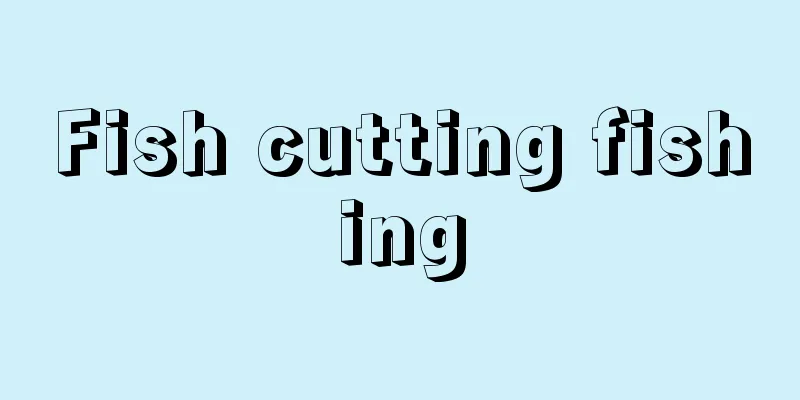Fish cutting fishing

|
...Even today, the "nori picking" (iwanori) harvesting that women do on rocks in the winter from Sanin to Hokuriku, and the "shellfish digging" that families enjoy doing on shallow sandy beaches during the spring tide, are both vestiges of this primitive form of fishing activity, and "poison fishing," in which poisonous plant roots are used to catch small fish in tidal flats and puddles, can also be said to be an extension of this gathering culture. At this stage, if people begin to use tools, they often initially repurpose tools used for other tasks on land for use near water. For example, the ``fire-waving fishing'' method, described in the Manyoshu as being performed by the people of Kuzu (Yamato region), is a fishing method that has been followed unchanged until recently, in which the fish gathered around a light held in one hand are hit with the back of a hatchet. ``Fish-cutting fishing,'' in which fish are caught from above the water by wading waist-deep in the shallow reefs of the Sulu Sea (southern Philippines) and the fish gathered around a fire from a lantern held in the left hand are quickly slashed with a boro (machete) in the right hand, is also an early stage in which such makeshift tools were used. *Some of the terminology that refers to "fish cutting fishing" is listed below. Source | Heibonsha World Encyclopedia 2nd Edition | Information |
|
…現代でも,山陰から北陸にかけて女性が従事する冬の岩場での〈海苔(のり)つみ〉つまりイワノリ採取も,遠浅の砂浜海岸で春の大潮に家族づれでにぎわう〈潮干狩り〉もいわばこのような原初形態の漁労活動のなごりであるし,草根の毒を使って干潟や水たまりの小魚を捕らえる〈毒漁poison fishing〉も,このような採集文化の延長上にあるといってよい。この段階で,道具を使用しはじめる場合,これも最初は陸上の他の作業に使う道具をそのまま水辺に転用することが多く,たとえば《万葉集》の国栖(くず)(大和地方)人が行ったという〈火振り漁〉は,片手にかざした灯火に集まってくる川魚を,鉈(なた)の背でたたくという形で最近までそのまま踏襲された漁法であるし,スールー海(フィリピン南部)の浅い磯で腰まで浸りながら左手にかざしたカンテラの火に集まる魚を右手のボロ(山刀)で水面上からすばやく切りつける〈魚切り漁〉も,そのようなありあわせの道具を使用した初期的段階のものである。 ※「魚切り漁」について言及している用語解説の一部を掲載しています。 出典|株式会社平凡社世界大百科事典 第2版について | 情報 |
>>: 《Study of Fish Fossils》 - Research on Fish Fossils
Recommend
Kaffir lily
...A perennial plant of the Amaryllidaceae family...
Yasugawa River
A river that flows through the southeastern part ...
Horntail (Tree wasp) - Horntail (English spelling)
A general term for insects belonging to the order ...
Petition of Right
…The gentry, common law experts, and Puritans uni...
sandhya (English spelling)
...This effect is especially strong on festival d...
Araria - Araria
Please see the Dizygoteka page. Source: Encyclopa...
Wei Hao
…Ming music was introduced to Nagasaki by Fujian ...
Grass vine - Grass vine
Please see the "Smilax" page. Source: E...
Exotoxin - Gaidokuso (English spelling)
Exotoxin. Also called extracellular toxin. A gener...
Epitaxial crystal growth
⇒Epitaxial growth Source: About Shogakukan Digital...
Approximation model - Kinji model
…And generally speaking, when we talk about a mod...
Beck, HG (English spelling) BeckHG
…Byzantine scholars have often pointed out that t...
Princess Tajima
Year of death: 25th June 1st Wadō (17th July 708) ...
Emperor Gokashiwabara
Year of death: 4/7/1526 (5/18/1526) Year of birth:...
Iwakumien
…Originally from Europe, it was invented to plant...









